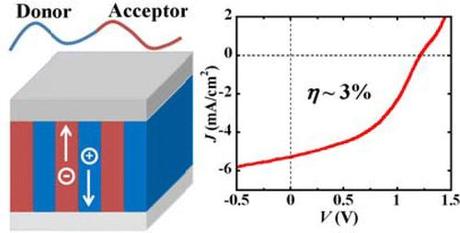
Source: Block copolymer schematic
& voltage efficiency reading
Researchers at Rice University and Pennsylvania State University published an article in the American Chemical Society journal Nano Letters. They detail the use of self-assembling organic materials based on block copolymers that function better than other materials used for the same purpose.
Their theory is based on two components needed at any time within a solar cell -- negative electrons carried on one end and positive charges carried on the other. Current is formed when there becomes an in-balance between these two caused by energy in the form of sunlight. Its a bit confusing but these researchers are very confident this design could decrease the cost of solar cells in the near future.
"Researchers want to experiment with other block copolymers and learn to control their structures to increase the solar cell's ability to capture photons and turn them into electricity". "On paper, block copolymers are excellent candidates for organic solar cells, but no one has been able to get very good photovoltaic performance using block copolymers," said Rice University's chemical engineer Rafael Verduzco (ref). They report that their plan is to achieve higher performance from these cells, then turn to long-term use, and stability.
Original Article: Nano Letters
